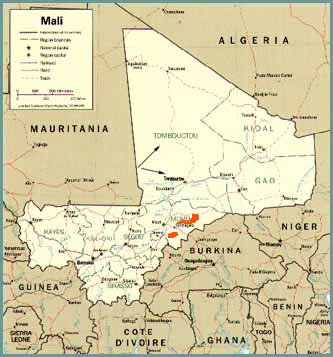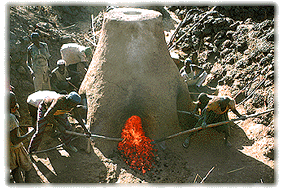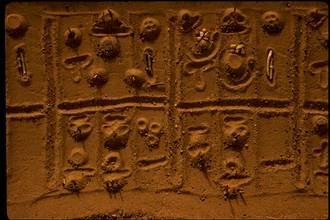
How true is it in terms of ethnography?
Meet the Dogon! A people numbering about 250,000 mostly living in
Bandiagara, Mali, West Africa (Red blotches on map)
 |
Let's get this straight about the Dogon: They are not "stone age" in any way. In Africa and Asia there are numerous tribes which could be so described, subsisting by foraging in a hunter-gatherer lifestyle, with minimal material support. |
†
†
Dogon are by comparison a sedentary agricultural people with a rich and sophisticated material culture. Arts they can count their own include:
 |
smelting iron, † †
|
|||||
| working it into tools, growing a subsistence crop in poor and rocky soil, fishing, † † † |
|
|||||
|
house building, granary building, locksmithery, † † † |
|||||
| pottery, weaving, dyeing, basketry,
leatherwork, † †
|
|
|||||
|
painting, mask-making, † † |
|||||
| and sculpture. † † †
|
|
 |
It should
be no surprise that they also posess systems of symbolic
respresentation... and even some astronomy. † † |
Real Dogon Facts about Sirius
Dogon do know Sirius.
They call it dana tolo -- the hunter's star.
Orion's Belt represents the game and the dogs.
They do not call it sigu tolo.
It is not connected with the 60-year sigu festival.
They do not know about po tolo or eme ya tolo.
The Dogon do have secrets, but not about Sirius.
(From "Dogon Restudied" by Walter EA van Beek, Current Anthropology, Vol 32, Number 2, April 1991 p. 139)
Prof van Beek's article is a comprehensive critique of the work
of Marcel Griaule, who published Un Systeme Soudanais de
Sirius with Germaine Dieterlen in 1950, which claimed that
Sirius or "sigi tolo" was connected with the 60 year
"Sigi" festival, that sigi tolo was orbited by "po
tolo" and "emme ya tolo", and that this
information was secret.
Marcel Griaule, who died in 1956, is still a hugely regarded
anthropologist. See this exhibition of his
work. His erstwhile collaborators are still highly regarded in
the field. Empirical works he produced before WWII, such as Masques
Dogons, still contain much valid ethnography. So why the
discrepancy between Griaule and van Beek over Sirius?
Next
